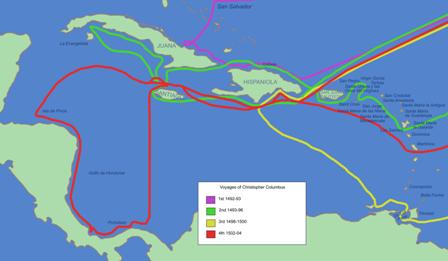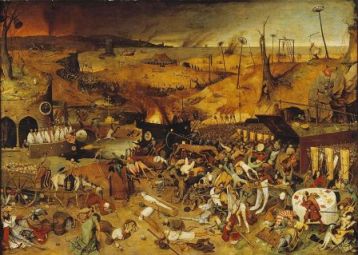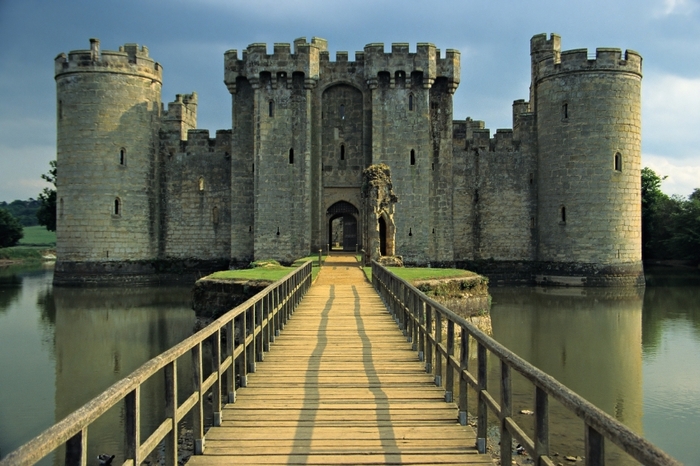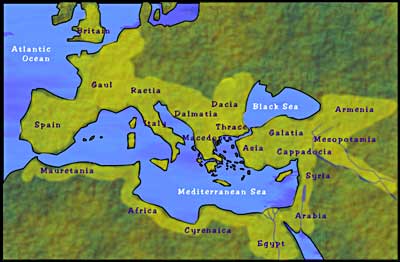EXPLORERS....
Columbus, Magellan and Vespucci
1. Christopher Columbus
Fun Facts to music
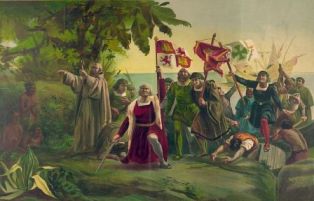
Columbus arriving in the Americas
- Columbus is the explorer who is credited for discovering America. Of course, there were already people living in America at the time who we call Native Americans. There even was a European, Leif Ericsson, who had been to the America's before. However, it was Columbus' voyage that started the exploration and colonization of the Americas.
Before the Voyage
Columbus was born in Genoa, Italy in 1451. He later lived in Lisbon where he worked as a trader. He learned how to make maps and navigate a ship.
A Shortcut to China
Columbus and his brother, Bartholomew, knew that there were great riches to be had in China and East Asia. However, traveling overland by the Silk Road was dangerous and a sea route around Africa seemed much too long. Columbus thought he could sail straight to China by crossing the Atlantic Ocean.It would turn out that Columbus was wrong. The Earth was much larger than he thought and there was another land, the Americas, between Europe and Asia.
Three Ships and a Long Voyage
Columbus spent years trying to convince someone to pay for his voyage. He first tried to get King John II of Portugal to pay for his journey, but the King was not interested. Finally, he was able to convince Queen Isabella and King Ferdinand of Spain to pay for the trip. He set sail on August 12, 1492 with three ships named the Nina, the Pinta, and the Santa Maria. The voyage was long and difficult. At one point his men threatened to mutiny and wanted to turn back. Columbus promised them he would turn back in two days if they didn't find land. In his journal, however, he wrote that he had no intention of turning back.
Finding Land
On October 12, 1492 land was spotted. It was a small island in the Bahamas that Columbus would name San Salvador. He met natives there that he called Indians because he was convinced that he had landed on islands off the coast of East Asia. He also visited other islands in the Caribbean such as Cuba and Hispaniola.
Returning Home
After making his discovery, Columbus was eager to return home to Spain and claim his riches. Only the Pinta and the Nina were able to return to Spain, however, as the Santa Maria wrecked off the coast of Hispaniola. Columbus left 43 men behind on the island to start up an outpost.
Upon returning home, Columbus was treated like a hero. He presented some of the things he had found including turkeys, pineapples, and some natives he had captured. The King of Spain was pleased enough to fund future expeditions.
More Voyages
Columbus would make three more voyages to the Americas. He explored more of the Caribbean and even saw mainland America. He had some difficulties in being the local governor and was even arrested for his behavior and for mistreating some of the colonists. Columbus died on May 20, 1506. He died thinking he had discovered a shortcut to Asia across the Atlantic Ocean. He never knew what an amazing discovery he had made.
Fun Facts about Christopher Columbus
- Columbus was first buried in Spain, however his remains were later moved to Santo Domingo in the new world and then back, again, to Spain.
- Columbus brought horses to the new world on his second voyage.
- In his original calculations, he thought that Asia would be 2,400 miles from Portugal. He was way off. It is actually 10,000 miles away! Not to mention the huge continent in between.
- You can remember the date Columbus discovered America by using this rhyme "In 1492 Columbus sailed the ocean blue".
- The sailor who was first to spot land on the voyage would receive a reward. The winner was Rodrigo de Triana who spotted land from the crow's nest of the Pinta
2. Ferdinand Magellan
https://youtu.be/Y94s85-Crew
The ancient Greek scientist and philosopher, Aristotle, declared that the Earth was round in 350 B.C., but for centuries many people did not believe him. The idea that the Earth was flat continued for hundreds of years. Ferdinand Magellan was the first person to prove that the Earth is round, not flat. How did he do it? By sailing around the Earth.
Ferdinand Magellan was born to noble parents in Portugal in 1480. His parents died when he was a child, and he was sent to be a page to the queen. During this time, he attended school and studied geography, navigation, astronomy and cartography.
As a young man, he became a sailor and later convinced the Spanish king, Charles V, to finance a voyage. Magellan wanted to travel westward to reach Asia and the Spice Islands.
Fun Facts About Ferdinand Magellan for Kids
- During the Middle Ages, spices, such as nutmeg, cloves and pepper were in high demand. The wealthy wanted them as flavorings for food. They also used them in perfumes and medicines.
- The trade routes to India and the Spice Islands were dangerous. Pirates lay waiting to attack at sea and people frequently fought over the land routes.
- Magellan set sail on the 20th of September in 1519, with five boats headed to Brazil. He sailed down the east coast of South America to Patagonia. There, one of the ships was destroyed by mutinous crew members.
- The remaining four ships sailed on. Over a year into their journey, they traveled through a channel that connects the Pacific Ocean to the Atlantic Ocean. This channel lies in Chile and is known as the Strait of Magellan. It took over a month to travel through the Strait of Magellan. One of the captains deserted, taking his ship back to Spain.
- Magellan thought it would be an easy trip to the Spice Islands. He was wrong about the distance. It took the men almost six months to sail to the Spice Islands.
- Just a few weeks after reaching Indonesia, Magellan was killed by a poisoned arrow in a battle with local tribes. His crew sailed back to Spain without him, reaching land in 1522.
3. Amerigo Vespucci
It was not until
1507 that people began to realize that what Columbus had discovered was
not a new route to India, but instead was a completely new world. The
first person to suggest that this was the case was an Italian explorer
by the name of Amerigo Vespucci.
Because he was the
first to realize that a new world had been discovered, map makers began
calling this new land the ‘Americas’ in honor of him.

Click link below to learn more about this explorer...
for whom the Americas were named!
https://youtu.be/ZSuznTcWcP4
To Quiz yourself on your knowledge of Christopher Columbus...
play this walk the plank game!
https://schoolhistory.co.uk/games/walk/walk_columbus.html
